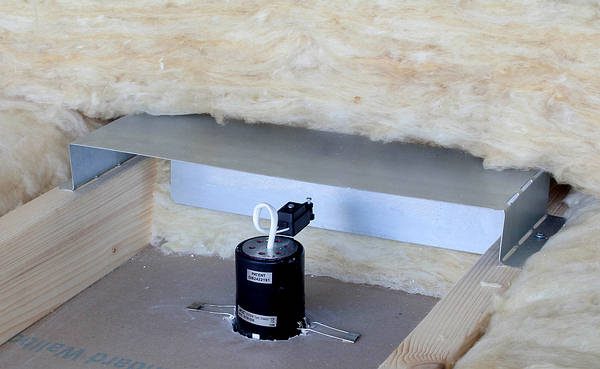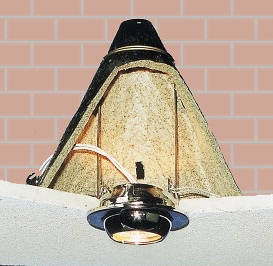I have written this guide to downlights for visitors to this forum. Its aim is to answer FAQs - there seems to have been a lot of queries lately. I have emailed admin, with a view to making a permenant version of this a sticky on Electrics UK. Please dont bleat about the Wiki - its plain nobody looks there. And the search function is next to useless.
Anyway, here goes. I am after any pointers or criticisms before the real version goes live.
Anyway, here goes. I am after any pointers or criticisms before the real version goes live.
Steve's (almost) comprehensive guide to downlighters.
Things you might not know:
12 volt lighting setups are descriped as EXTRA LOW VOLTAGE.
230 volt lighting setups are described as LOW VOLTAGE - as is anything at 230 volt.
Both use the same amount of electricity - a lamp being 12 volt does not mean it'll use 1/20th of the energy of an equivalent 230 volt lamp. A watt is a watt, whether at 12 volts or 50,000 volts.
Premade kits from B&Q are pants. Buy the stuff seperately, preferably at a wholesaler or online (screwfix or TLC).
You should keep the discs of ceiling you cut out, and keep it safe for when you decide you dont want downlighters, and it'll be a doddle to replace when you get fed up with downlights.
So what are the differences?
230 volt setups are simple to install. There is no transformer, therefore less wiring, and crucially, less to go wrong in future. There are compact fluorescent lamps (CFLs) available for 230 volt fittings, rated at 7, 9 and 11 watt. Feelings are mixed on these, as they have issues with warmup times and some people dont like the light they give. See here for a review of the three lamp types available.
12 volt setups are therefore more complex to install, as they require a transformer. The transformer must be installed in a cool place, away from the heat of the downlight body. Transformers themselves give off heat, so they must not be insulated, as this will lead to premature failure. Cheap transformers can fail as often as the lamp itself. There are several types of transformer available, which we'll talk about later. 12 volt lamps give slightly better colour rendition.
What do I need to know before fitting them?
It depends on the room. The main concern should be fire.
Firstly, the heat given off by halogen downlights.
*You should fit them in the middle of joist cavities, so that they are away from the flammable timbers. Care should be taken setting out to ensure this happens.
*If you are fitting in an upstairs room with a loft above, you must ensure the insulation is kept away from the very hot lamp. BUT you must not contravene building regulations by removing the insulation. This can be done by using a "loftbrace":

Alternatively you can use a box of plasterboard above each lamp, a foot square. But both are a bodge, because they will still allow heat to build up close to the downlight. The fact is, there is no way to satisfactorily install downlights adjoining a loft without contravening the building regs in some part.
*If the ceiling is lath and plaster, you shouldnt fit halogen lamps. The old laths are extremely dry and flammable. If you want halogen lamps, you should choose a fitting with the F mark, which means its suitable for mounting in combistible surfaces. See diagrams at end. But you wont find many halogen fittings with the F mark. The other solution is to cut out a square of laths and plaster, and replace with plasterboard, with is not flammable. But once you cut into the laths, you might find it just as easy to replace the entire ceiling! You should also make sure to clear any rubbish from around the downlight. Rubbish is flammable - sawdust, electricians scrap, plumbers scrap etc.
We also have to consider the fire rating of the ceiling itself.
*If you live in a multi-dwelling property (flats), you will probably have a fire rated ceiling. This means the ceiling is designed to withstand the effects of fire for certain lengths of time (30, 60 or 90 minutes), such that if a fire were to break out in your dwelling, it would not spread to the dwelling above. So you're about to pepper your ceiling with holes! You need to retain the fire rating. For this we use fire hoods.
Note that you only need to use fire hoods or fire rated fittings, where fire rated ceilings exist (flats and lived-over garages). Do not let your electrician fit them unless he has to, because they hold heat close to the fitting. They are not for keeping insulation at bay - other solutions exist for this, as above.
But I'm fitting cool-running lamps.
You still need to follow the advice above. If you have a fitting capable of being fitted with halogen lamps, you must treat it as if you are fitting these, in case someone fits them in future. There are fittings available that can only accept CFLs, such as these. The lamp and fitting are "keyed" so that only CFLs can be fitted. The fitting is plastic anyway, so would melt if fitted with halogen. Solid state LED fittings are also available, which could be fitted in contact with insulation (depending on the manufacturers instructions).
I want to dim halogen lamps.
The simple answer is "dont". Halogen lamps work on a certain principle for long life. When running, the filament "boils off" tungsten. This tungsten is deposited on the quartz capsule. The glass capsule is very hot, and a reaction with the halogen gas causes it to be deposited back onto the filament, where the cycle begins again. By dimming the lamp, you are cooling the lamp down, and this will impede the halogen process. Tungsten will boil off the filament, but it'll get stuck to the glass, and you'll end up with blackened lamps, and they'll fail quicker. See here for more.
The other problem with dimming is that the dimming isnt proportional to the energy consumption drop. So if you dim by 50%, you wont be saving 50% of energy. It might save 25% or 40%, but it wont be 50%. This is because the lamp itself doesnt work well at low brightness, and because of energy losses in the dimmer.
Further problems arise when you want to dim 12 volt lamps. The dimmer and transformer must be compatible. Try to brand match. For example, varilight's dimmers and transformers will be compatible. But if not, look for matching "trailing edge" or "leading edge" products (if the m'fr publishes such information - some dont).
Also, due to the nature of halogen lamps being a "high startup load", you must make sure the dimmer can handle it. This is normally done by using a dimmer rated double the lighting load. For example, 200 watts of halogen would require a 400 watt dimmer. But many manufacturers build their dimmers with this tolerance built in now. Be prepared to replace the dimmer when a lamp or transformer blows. They dont like surges.
What about bathrooms?
In a bathroom where the wiring is being altered to provide extra fittings (as is the case with downlights), the new lights must be afforded RCD protection. Chances are your house was wired to the 15th or 16th edition, which didnt require this. But the 17th edition does require RCD protection for all circuits in a bathroom. Dont panic - this isnt retrospective, you only need to worry if you are altering wiring, and it only affects new work. Small RCD enclosures can be fitted in-line to the bathroom lights.
Also, you should consider steam buildup. IP (ingress protection) rated fittings are recommended to prevent steam affecting the lamps. Specific fittings are marketed for bathrooms too.
Something else to consider is that the holes you make in a bathroom ceiling must be sealed above. This is to prevent moisture from getting into the loft and causing damp. This can be achieved by using a box of plasterboard above each lamp, sealed at their edges.
Why so many types of transformer?
Nowadays, the preferred transformer is electronic. This isnt a transformer as such, as it doesnt contain coils of wire around a magnetic core. It is a Switched Mode Power Supply, such as that which powers your laptop. It is lightweight and is very tolerant of voltage dips.
Toroidal transformers are going out of fashion. But many high street retailers still fit them in their fittings and downlight kits. They are heavy, and liable to trip circuit breakers due to their extremely high inrush current (like a motor starting). They are also less tolerant of being dimmed, and dimmers dont like them either.
The problem with both types of transformer is that far-eastern sweatshops knock them out by the hundred, with little quality control. Thus failure rates are high, and you can expect to replace them within the life of two lamps. I had two toroidals from B&Q, identical, one after the other. Both failed by the plastic sealed case cracking and exposing the coils inside.
The preferred method of using transformers is one per fitting. This way if a transformer fails, it only takes out one of your several lamps. It also saves searching for the transformer, if theres one at every fitting. Most electronics can be pulled through a downlight hole.
I've looked at the options and dont like the sound of them now. What else is there?
Well, commercial premises have used CFL (PL) downlights for a long time now. These are different to the ones I talked about in the link above, in that the lamp is just the tube. All the starting gear is in the fitting itself. This allows both to be bigger, and better. PL downlights start quicker and are brighter than CFLs. I recently had some fitted myself - see here. I cant rate them highly enough. More colour choice, more wattage choice, and much better for your energy bills and the planet.
What do the symbols on fittings mean?
A simple diagram:






